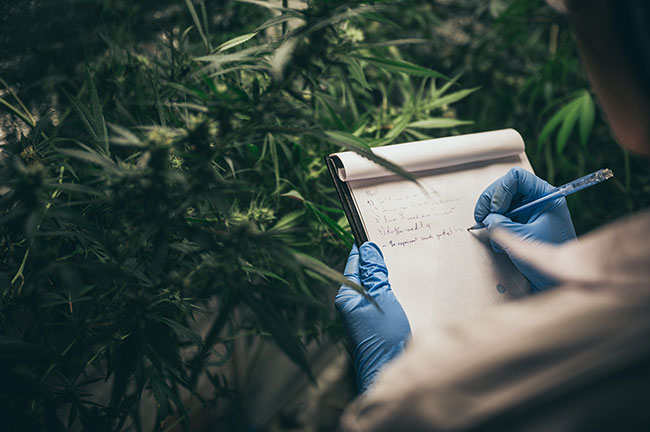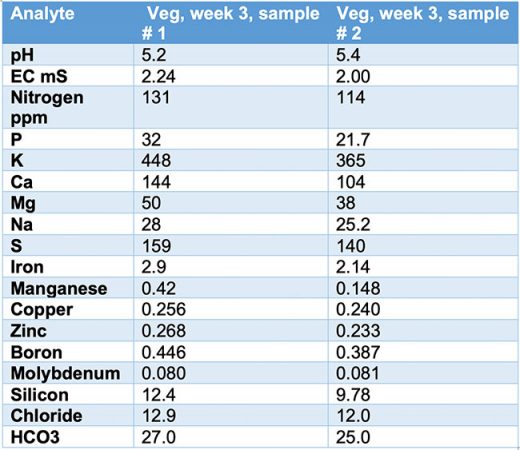
Features
Cultivation
Reading lab results
Making sense of cannabis tissue and nutrient solution analyses
July 5, 2021 By Gagandeep Singh Bhatoa and Mohyuddin Mirza
 (Photo: © chokniti / adobe stock)
(Photo: © chokniti / adobe stock) When there are 16 essential nutrients cannabis needs to grow and prosper, it becomes a complex task to understand and interpret each nutrient and determine deficiencies or toxicity. Then, there is the task of how to adjust the nutrients to make corrections. Different analytical labs provide their own sufficiency ranges and present data in good, readable and visual formats where comparisons can easily be made. Most of the growers test their nutrients in the fertilizer solution when they see a symptom or many symptoms on their plants.
Whether you’re a grower, processor or retailer, it’s important to know the full nutritional profile of your products. Cannabis nutrient testing provides an accurate profile of your growing media, source waters and plant materials. Growers should submit multiple leaf samples to the lab over the course of a plant’s growth cycle in order to gauge its overall nutrient composition. This helps identify growth deficiencies before they become serious and irreversibly affect plant health. It is desirable to take weekly samples and thus, build a database for your facility.
Essential nutrients
Having an understanding of the plant’s essential nutrients is the starting point to interpret the results from the lab. Besides carbon, hydrogen and oxygen, which cannabis plants need during the food manufacturing process of photosynthesis, we need to supply essential minerals. The macro elements are nitrogen, phosphorus, potassium, calcium, magnesium and sulphur.
These are needed relatively in larger amounts, like above 50 mg/l, hence the term “macro” elements. Cannabis plants also need micro elements like iron, manganese, copper, zinc, boron and molybdenum in quantities ranging from 0.10 mg/l to about 3.0 mg/l. Gain knowledge of the role of each element and remember that any one of them can become the limiting factor in reducing the growth and thus affecting plant’s performance and energy balance.
Nutrient mobility
Nitrogen, phosphorus, potassium, magnesium and sulfur are highly mobile elements. It means that these are stored in cell sap and can be moved by the plant if the upper leaves and shoots need it. As a result of this mobility, deficiency symptoms occur in the lower leaves.
On the other hand there are immobile elements which include calcium, boron, iron, manganese, copper and zinc. Thus, the deficiency symptoms first appear at the top of the cannabis plants. Some nutrients are more or less independent from each other and increase or decrease in the leaf tissue as the quantity is raised or lowered. Other nutrients operate in relation to each other and might not increase in the leaf tissue as the quantity is raised in the recipe.
Also, the pH of the root zone has a significant effect on uptake patterns; most micronutrients are more available at lower pH and macronutrients are more available at higher pH.

Table 2: Leaf analysis for micronutrients from recently mature leaves of cannabis (fourth leaf)
What nutrients to test
Cannabis leaf tissue testing is the most common method for determining nutritional breakdown, also known as foliar analysis, and is a useful tool for managing the nutritional content. To test the nutrient content in cannabis, take samples from recently mature leaves, not the very young nor the older leaves (generally the fourth or fiftth leaf from the top of the plant). About 12 leaves may be required because labs dry them to determine the moisture content. Ask for total nitrogen, phosphorus, potassium, calcium, magnesium, sulfur, sodium, iron, manganese, iron, copper, zinc, boron and molybdenum. These may be offered as a package. Silicon should also be included. We have seen aluminum is included by many labs as part of the package. If one takes older mature leaves, then calcium may appear to be very high.
It is recommended to send samples of your nutrient solutions when you are sending leaf samples to confirm a diagnosis of a deficiency or toxicity. Ask the lab for Nitrate nitrogen and ammoniacal nitrogen, phosphorus, potassium, calcium, magnesium, sodium, sulfur, iron, manganese, copper, zinc, boron and molybdenum. In addition, ask for chloride and silicon and bicarbonates. Most labs offer standard packages for cannabis which may not include silicon and bicarbonates.

Table 3: Nutrient analyses for the fertilizer solution related to leaf tissue results
Analyzing lab reports
Tables 1 and 2 show cannabis leaf tissue lab test results showing the quantity of each nutrient present in the leaves. This indicates how your nutrient recipe should be adjusted. It is obvious that potassium in the cannabis leaves is above the sufficiency range, while iron is very high. Manganese is low. One can ask how these sufficiency ranges were established. It appears that the analytical labs have some information from literature and their own database and have come up with comparative data.
In Table 3, when we look at the two nutrient samples analysed, one can see the reason for a spike in iron contents. The level of iron is adequate in both samples but with the pH values of 5.2 and 5.4, iron uptake is several times higher than at pH values of between 5.8 and 6.2. A toxicity is possible and symptoms would appear as brown, necrotic spots on the edges and spread over the leaves as well. So pH correction is the first measure. Manganese is low and that is the reason as to lower tissue levels. High potassium is of no concern. Potential toxicity due to potassium is very rare. Cannabis is a high potassium user and it can be stored in cell sap. Molybdenum was not tested in the tissue samples and the levels in the feed solution are on the lower side.
Bicarbonates are on the low side. They are not a nutrient for cannabis but they are important to in providing pH buffering to the solution. The pH likely dropped that low because of lower levels of bicarbonates. A suggested level is to maintain between 50 to 60 mg/l in the solution. Another important point is that interpretation of results should be done based on the health of the plants as well.
Don’t be afraid to ask for help in interpreting the results. It is a complex process and all aspects should be examined to take corrective measures.
Gagandeep Singh Bhatoa is a plant health care specialist in Lethbridge, Alta. Email him at gaganagrico@gmail.com.
Mohyuddin Mirza, PhD, is an industry consultant in Edmonton, Alta. He can be reached at drmirzaconsultants@gmail.com.
Print this page